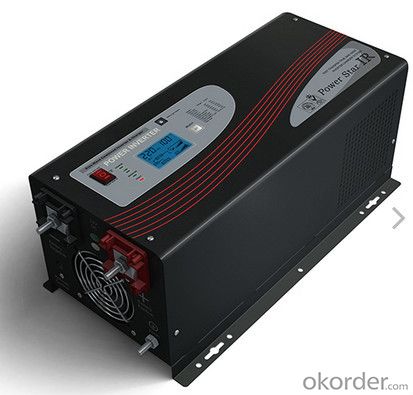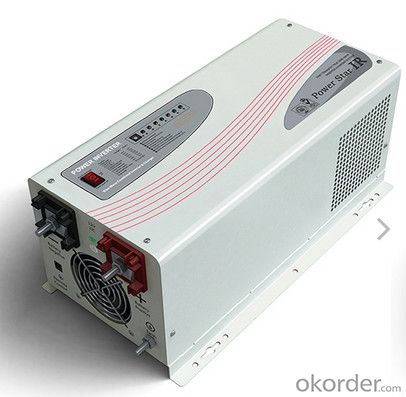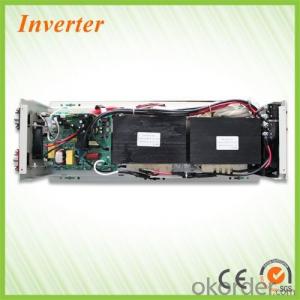2015 Top Selling South Africa EP 3000 48V 6000W Solar Charger Inverter
- Loading Port:
- Ningbo
- Payment Terms:
- TT OR LC
- Min Order Qty:
- 500 pc
- Supply Capability:
- 10000 pc/month
OKorder Service Pledge
OKorder Financial Service
You Might Also Like
2015 Top Selling South Africa EP 3000 48V 6000W Solar Charger Inverter
Features of EP3000 Series 48V 6000W Solar Charger Inverter :
High efficiency over 90%
12Vac/24Vac/48Vac
Max.charge current 70A
Inbuilt pure copper transformer
Automatic three-stage battery Charger
RS232 with free CD(option)
Solar first function(option)
Charge current adjustable(option)
Remote control(option)
CE certificate, Soncap certificate.
Product Picts of EP3000 Series 48V 6000W Solar Charger Inverter :


| Rated Capacity | 1000W | 1500W | 2000W | 3000W |
| Efficiency | >90% | |||
| Input | ||||
| Model | 120v Models | 230v Models | ||
| Nominal Voltage | 100V/110V/115V/120V Selectable | 200V/220V/230V/240V Selectable | ||
| Output | ||||
| Rated Power | 1000W | 1500W | 2000W | 3000W |
| Output Voltage | 100V/110V/115V/120V Selectable | 200V/220V/230V/240V Selectable | ||
| Voltage Waveform | Pure Sine Wave | |||
| Crest Factor | 3:1 | |||
| Regulation(Nominal) | ±10% Typical Of Nominal Voltage | |||
| Transfer Time | Transfer Time : AC To DC : 10ms (Typical) Transfer Time : DC To AC : 10ms(Typical ) | |||
| Max Bypass Overload Current | 30A | |||
| Input | ||||
| Nominal Voltage | DC12V/24V | DC12V/24V | DC12V/24V | DC24V/48V |
| Over Current Protection | By Re-Settable Over Current Protector | |||
| Output | ||||
| Nominal Input Voltage | 230Vac | |||
| Input Voltage Range | 185~265Vac | |||
| Nominal Charge Current | 35amp-70amp | |||
| Charger Short Circuit Protection | Circuit Breaker | |||
| Over Charge Protection | Bat. V ≥ 15.7Vdc/31.4Vdc/62.8Vdc Beeps 0.5s Every 1s & Fault After 60s | |||
| Battery Type | Lead-Acid 12Ah ~ 250Ah | |||
| Typical Backup Time | No Limit, Depend on external battery | |||
| Average Charging Current | 35A/20A | 45A/30A | 65A/35A | 75A/30A |
| Battery voltage Option | ||||
| Options 7 | Battery low trip to bypass 11v , high trip to battery 14v | |||
| Options 8 | Battery low trip to bypass 10.5v , high trip to battery 13.5v | |||
| Options 9 | Battery low trip to bypass 10v , high trip to battery 13v | |||
| Communications & Management | ||||
| Control Panel | LCD/LED Option | |||
| Audible Alarm | Alarm On Battery:Low Battery & Battery Over Voltage Alarm On Abnormal Operation: Over Load, Short-Circuit, & Over Heat | |||
| Environment and Safe | ||||
| Operating Temperature | 0℃ To 40℃ (32℉ To 104℉) | |||
| Transit/Storage Temperature | -15℃ To 60℃ | |||
| Audible Noise | 60 Dba Max at 1m | |||
| Quality Control System | ISO 9001,CE,FCC | |||
| Physical | ||||
| Dimensions: (H×D×W) | 570*320*315mm | |||
| G.W (Kg) | 19 | 19 | 22.5 | 27.5 |
| Packing | Export Carton For Each Unit Per Carton | |||


Warrenty
provides a 1~3 year limited warranty (“Warranty”) against defects in materials and workmanship for its Uninterruptible power supply, Power inverter/chargers, Solar charge controllers, Battery Products (“Product”).
The term of this Warranty begins on the Product(s) initial purchase date, or the date of receipt of the Product(s) by the end user, whichever is later. This must be indicated on the invoice, bill of sale, and/or warranty registration card submitted to MUST-Solar. This Warranty applies to the original MUST-Solar Product purchaser, and is transferable only if the Product remains installed in the original use location.
FAQ
1. How do I decide which system is right for me ?
For protection from long outages, include a generator or solar panels in your Must solar system. Shorter outages can be handled by a battery-only system.
2. Where my system will be installed ?
Must solar systems are usually wall-mounted near a home's main electrical (circuit breaker) panel.
3. How do I install my system ?
A must solar backup inverter is connected to a home electric system , we will supply detailed installation manual and videos for our customers .
4. How fast will my system respond to a power outage ?
Must solar inverters typically transfer to battery power in less than 16 milliseconds (less than 1/50th of a second).
- Q:How is the size of a solar inverter determined?
- The size of a solar inverter is determined based on the maximum power output of the solar panels connected to it. It should match or exceed the total capacity of the solar panels to ensure optimal performance and avoid any power limitations.
- Q:What are the safety measures to consider when installing a solar inverter?
- When installing a solar inverter, several safety measures should be considered. Firstly, it is important to ensure that the installation is performed by a qualified and certified professional to minimize the risk of accidents. It is crucial to follow the manufacturer's guidelines and recommendations during the installation process. Additionally, it is essential to disconnect the solar inverter from the power source before starting any installation or maintenance work to prevent electrocution. Proper grounding and wiring techniques should be followed to reduce the risk of electric shock or fire hazards. Adequate ventilation and temperature control should be provided to prevent overheating of the inverter. Regular inspections and maintenance checks should be conducted to ensure the inverter's safe and efficient operation. Overall, prioritizing safety measures during the installation process is crucial to protect both the installer and the system's end-users.
- Q:How does a solar inverter handle voltage fluctuations from the grid?
- A solar inverter handles voltage fluctuations from the grid by constantly monitoring the voltage and adjusting its output accordingly. When the grid voltage increases or decreases, the inverter's control system regulates its own output voltage to match the changes, ensuring a stable and consistent supply of electricity is fed into the grid. This helps to maintain grid stability and protect the connected devices from potential damage caused by voltage fluctuations.
- Q:How does a solar inverter protect against lightning strikes?
- A solar inverter typically protects against lightning strikes by incorporating surge protection devices and grounding systems. These features help to divert the excess energy caused by a lightning strike away from the sensitive electronic components of the inverter, preventing damage and potential electrical hazards.
- Q:How the output voltage of the PV inverter and the grid-connected voltage are determined
- Inverter is the DC power (battery, battery) into alternating current (usually 220V, 50Hz sine wave). It consists of inverter bridge, control logic and filter circuit. Widely used in air conditioning, home theater, electric wheel, power tools, sewing machines, DVD, VCD, computer, TV, washing machine, range hood, refrigerator, video recorders, massage, fan, lighting and so on. In foreign countries
- Q:How does a solar inverter protect against overvoltage?
- A solar inverter protects against overvoltage by continuously monitoring the voltage levels of the solar panels. If the voltage exceeds a certain threshold, the inverter automatically reduces the power output or disconnects from the grid to prevent damage to the system and ensure the safety of the electrical components.
- Q:Are there any voltage or frequency regulations for solar inverters?
- Yes, there are voltage and frequency regulations for solar inverters. These regulations vary by country and are typically established by regulatory bodies or standards organizations. They ensure that the output voltage and frequency of solar inverters meet the required standards to ensure grid compatibility and prevent any potential damage to the electrical infrastructure.
- Q:Are there any maintenance requirements for a solar inverter?
- Yes, solar inverters require regular maintenance to ensure optimal performance and longevity. This typically includes cleaning the unit and its surroundings to prevent dust buildup, checking for any loose connections or wiring issues, inspecting for physical damage, and monitoring the inverter's performance through regular system checks. Additionally, firmware updates and software upgrades may be necessary to enhance efficiency and address any potential issues.
- Q:What is the maximum operating temperature of a solar inverter?
- The maximum operating temperature of a solar inverter can vary depending on the specific model and brand. However, most solar inverters are designed to operate within a temperature range of -20°C to 60°C (-4°F to 140°F). It is important to check the manufacturer's specifications to determine the exact maximum operating temperature for a particular solar inverter.
- Q:What are the advantages of using a solar inverter with battery storage?
- The advantages of using a solar inverter with battery storage include: 1. Energy independence: With a solar inverter and battery storage system, you can generate, store, and use your own electricity, reducing your reliance on the grid and ensuring a continuous power supply even during grid outages. 2. Increased self-consumption: The battery storage allows you to store excess solar energy generated during the day for use at night or during cloudy days, maximizing self-consumption and reducing the need to purchase electricity from the grid. 3. Time-of-use optimization: By storing excess solar energy and using it during peak demand periods, you can take advantage of time-of-use pricing, where electricity rates are higher during peak times. This can help you save money on your electricity bills. 4. Backup power: During power outages, the battery storage system can provide backup power, ensuring that critical appliances or equipment continue to function. This is particularly beneficial for homes or businesses that require uninterrupted power supply. 5. Environmental benefits: Solar energy is a clean and renewable source of energy. By using a solar inverter with battery storage, you can reduce your carbon footprint and contribute to a greener future by minimizing reliance on fossil fuels. 6. Grid support and stability: Battery storage systems can also provide grid support services, such as frequency regulation and peak shaving. This helps to stabilize the grid and improve overall energy efficiency. Overall, using a solar inverter with battery storage offers numerous advantages, including energy independence, cost savings, environmental benefits, and improved reliability of power supply.
1. Manufacturer Overview |
|
|---|---|
| Location | |
| Year Established | |
| Annual Output Value | |
| Main Markets | |
| Company Certifications | |
2. Manufacturer Certificates |
|
|---|---|
| a) Certification Name | |
| Range | |
| Reference | |
| Validity Period | |
3. Manufacturer Capability |
|
|---|---|
| a)Trade Capacity | |
| Nearest Port | |
| Export Percentage | |
| No.of Employees in Trade Department | |
| Language Spoken: | |
| b)Factory Information | |
| Factory Size: | |
| No. of Production Lines | |
| Contract Manufacturing | |
| Product Price Range | |
Send your message to us
2015 Top Selling South Africa EP 3000 48V 6000W Solar Charger Inverter
- Loading Port:
- Ningbo
- Payment Terms:
- TT OR LC
- Min Order Qty:
- 500 pc
- Supply Capability:
- 10000 pc/month
OKorder Service Pledge
OKorder Financial Service
Similar products
New products
Hot products
Hot Searches
Related keywords































